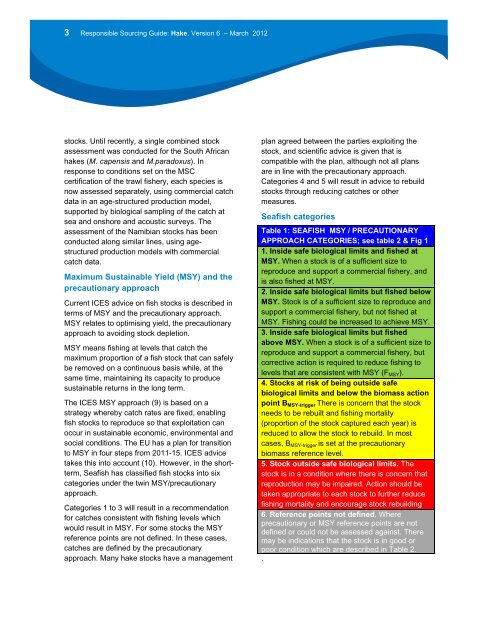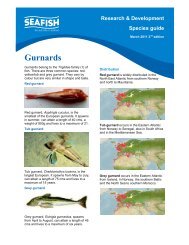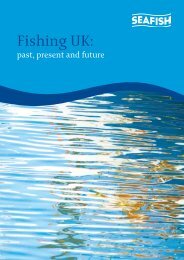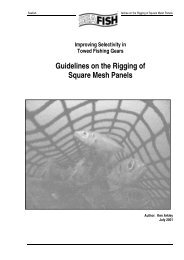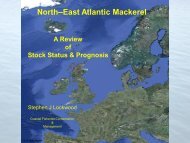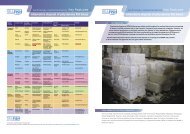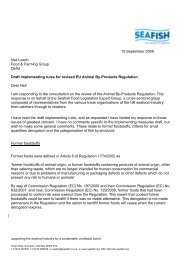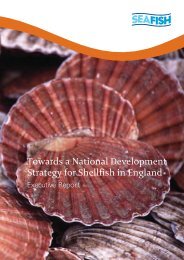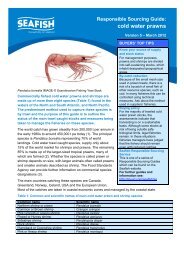Hake 2012 - Seafish
Hake 2012 - Seafish
Hake 2012 - Seafish
Create successful ePaper yourself
Turn your PDF publications into a flip-book with our unique Google optimized e-Paper software.
3 Responsible Sourcing Guide: <strong>Hake</strong>. Version 6 – March <strong>2012</strong><br />
stocks. Until recently, a single combined stock<br />
assessment was conducted for the South African<br />
hakes (M. capensis and M.paradoxus). In<br />
response to conditions set on the MSC<br />
certification of the trawl fishery, each species is<br />
now assessed separately, using commercial catch<br />
data in an age-structured production model,<br />
supported by biological sampling of the catch at<br />
sea and onshore and acoustic surveys. The<br />
assessment of the Namibian stocks has been<br />
conducted along similar lines, using agestructured<br />
production models with commercial<br />
catch data.<br />
Maximum Sustainable Yield (MSY) and the<br />
precautionary approach<br />
Current ICES advice on fish stocks is described in<br />
terms of MSY and the precautionary approach.<br />
MSY relates to optimising yield, the precautionary<br />
approach to avoiding stock depletion.<br />
MSY means fishing at levels that catch the<br />
maximum proportion of a fish stock that can safely<br />
be removed on a continuous basis while, at the<br />
same time, maintaining its capacity to produce<br />
sustainable returns in the long term.<br />
The ICES MSY approach (9) is based on a<br />
strategy whereby catch rates are fixed, enabling<br />
fish stocks to reproduce so that exploitation can<br />
occur in sustainable economic, environmental and<br />
social conditions. The EU has a plan for transition<br />
to MSY in four steps from 2011-15. ICES advice<br />
takes this into account (10). However, in the shortterm,<br />
<strong>Seafish</strong> has classified fish stocks into six<br />
categories under the twin MSY/precautionary<br />
approach.<br />
Categories 1 to 3 will result in a recommendation<br />
for catches consistent with fishing levels which<br />
would result in MSY. For some stocks the MSY<br />
reference points are not defined. In these cases,<br />
catches are defined by the precautionary<br />
approach. Many hake stocks have a management<br />
plan agreed between the parties exploiting the<br />
stock, and scientific advice is given that is<br />
compatible with the plan, although not all plans<br />
are in line with the precautionary approach.<br />
Categories 4 and 5 will result in advice to rebuild<br />
stocks through reducing catches or other<br />
measures.<br />
<strong>Seafish</strong> categories<br />
Table 1: SEAFISH MSY / PRECAUTIONARY<br />
APPROACH CATEGORIES; see table 2 & Fig 1<br />
1. Inside safe biological limits and fished at<br />
MSY. When a stock is of a sufficient size to<br />
reproduce and support a commercial fishery, and<br />
is also fished at MSY.<br />
2. Inside safe biological limits but fished below<br />
MSY. Stock is of a sufficient size to reproduce and<br />
support a commercial fishery, but not fished at<br />
MSY. Fishing could be increased to achieve MSY.<br />
3. Inside safe biological limits but fished<br />
above MSY. When a stock is of a sufficient size to<br />
reproduce and support a commercial fishery, but<br />
corrective action is required to reduce fishing to<br />
levels that are consistent with MSY (F MSY ).<br />
4. Stocks at risk of being outside safe<br />
biological limits and below the biomass action<br />
point B MSY-trigger There is concern that the stock<br />
needs to be rebuilt and fishing mortality<br />
(proportion of the stock captured each year) is<br />
reduced to allow the stock to rebuild. In most<br />
cases, B MSY-trigger is set at the precautionary<br />
biomass reference level.<br />
5. Stock outside safe biological limits. The<br />
stock is in a condition where there is concern that<br />
reproduction may be impaired. Action should be<br />
taken appropriate to each stock to further reduce<br />
fishing mortality and encourage stock rebuilding.<br />
6. Reference points not defined. Where<br />
precautionary or MSY reference points are not<br />
defined or could not be assessed against. There<br />
may be indications that the stock is in good or<br />
poor condition which are described in Table 2.<br />
.


